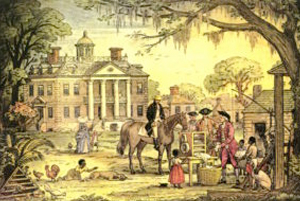 This week’s #MarkerMonday highlights Mulberry Grove plantation, situated a few miles south of present day Port Wentworth, Georgia, and its early colonial history. To ensure the safety and protection of his new colony, Oglethorpe designated a military outpost a few miles outside of Savannah, called Joseph’s Town. The outpost was once home to the Scottish Highlanders who came to Georgia in 1735 on their ship, Prince of Wales. Part of the original acreage of Joseph’s Town became the site of Mulberry Grove Plantation in the late 1730s. Mulberry trees were cultivated at Mulberry Grove Plantation for use in Georgia’s silk industry, giving the site its name. Once the Georgia Trustees’ original ban on slavery in Georgia was lifted in 1750, Mulberry Grove planters began to focus intensely on rice production. In 1774, Mulberry Grove was purchase by John Graham, Royal Lieutenant Governor of Georgia. Graham purchased additional land surrounding the plantation and to expand rice production, greatly increasing the number of slaves living and working at Mulberry Grove.
This week’s #MarkerMonday highlights Mulberry Grove plantation, situated a few miles south of present day Port Wentworth, Georgia, and its early colonial history. To ensure the safety and protection of his new colony, Oglethorpe designated a military outpost a few miles outside of Savannah, called Joseph’s Town. The outpost was once home to the Scottish Highlanders who came to Georgia in 1735 on their ship, Prince of Wales. Part of the original acreage of Joseph’s Town became the site of Mulberry Grove Plantation in the late 1730s. Mulberry trees were cultivated at Mulberry Grove Plantation for use in Georgia’s silk industry, giving the site its name. Once the Georgia Trustees’ original ban on slavery in Georgia was lifted in 1750, Mulberry Grove planters began to focus intensely on rice production. In 1774, Mulberry Grove was purchase by John Graham, Royal Lieutenant Governor of Georgia. Graham purchased additional land surrounding the plantation and to expand rice production, greatly increasing the number of slaves living and working at Mulberry Grove.

Drawing of Mulberry Grove Plantation, 1794. Georgia Historical Society Collection of Photographs 1870-1960, 1361PH-01-17-6162.
When the American Revolution began, John Graham remained loyal to the Crown and was forced to flee Mulberry Grove when it was confiscated by patriot forces. Following the war, Graham and his family returned to Great Britain. In 1789, he filed a claim with the British Government to recover his losses sustained during the war in Savannah. Mulberry Grove was not returned to Graham after the war but was instead granted to American Major General Nathanael Greene by the State of Georgia for his military services. Today, the land where Mulberry Grove was situated is owned by the Georgia Ports Authority.
Explore the links below to learn more about Mulberry Grove Plantation, Lieutenant Government John Graham, and Georgia’s colonial history.
GHS is proud to house a transcript of John Graham’s claim to the British Government to recover his losses, a letter from John Graham to British Colonel James Grierson, and two releases of land from John Graham to Pierce Butler for land on St. Simons Island.
New Georgia Encyclopedia: Agriculture in Georgia, Overview
Mulberry Grove Foundation, Inc.
AJC.com: How Should Mulberry Grove be remembered?
Geneology.com: RE: Royal Lt Governor John Graham, Georgia
Further Reading
Coleman, Kenneth. Georgia History in Outline. Athens, GA: University of Georgia Press, 1978.
The Georgia Historical Quarterly has published several articles related to Mulberry Grove, John Graham, and the American Revolution in Georgia which can be accessed on JSTOR. If your library does not have access to JSTOR, you can go to www.jstor.org and create a free MyJSTOR Account.
- Braddock, J. G. "The Plight of a Georgia Loyalist: William Lyford, Jr." The Georgia Historical Quarterly91, no. 3 (2007): 247-65. http://www.jstor.org/stable/40585013.
- Cole, Richard C. "The Siege of Savannah and the British Press, 1779-1780." The Georgia Historical Quarterly65, no. 3 (1981): 189-202. http://www.jstor.org/stable/40580789.
- Harden, William. "SIR JAMES WRIGHT: Governor of Georgia by Royal Commission, 1760-1782." The Georgia Historical Quarterly2, no. 1 (1918): 22-36. http://www.jstor.org/stable/40575574.
- Lambert, Robert S. "The Confiscation of Loyalist Property in Georgia, 1782-1786." The William and Mary Quarterly 20, no. 1 (1963): 80-94. doi:10.2307/1921356.
- Mitchell, Robert G. "The Losses and Compensation of Georgia Loyalists." The Georgia Historical Quarterly68, no. 2 (1984): 233-43. http://www.jstor.org/stable/40581224.
- Savannah Unit, Federal Writers' Project, Work Projects Administration of Georgia. "MULBERRY GROVE IN COLONIAL TIMES." The Georgia Historical Quarterly23, no. 3 (1939): 236-52. http://www.jstor.org/stable/40576646.
- Stegeman, John, and Janet Stegeman. "President Washington At Mulberry Grove." The Georgia Historical Quarterly61, no. 4 (1977): 342-46. http://www.jstor.org/stable/40580415.
Related Marker Monday Posts
Marker Monday: The Trustees Garden (Posted September 19, 2016)
Marker Monday: Nathanael Greene Monument (Posted August 7, 2017)
Marker Monday: Johnson Square (Posted February 26, 2018)
